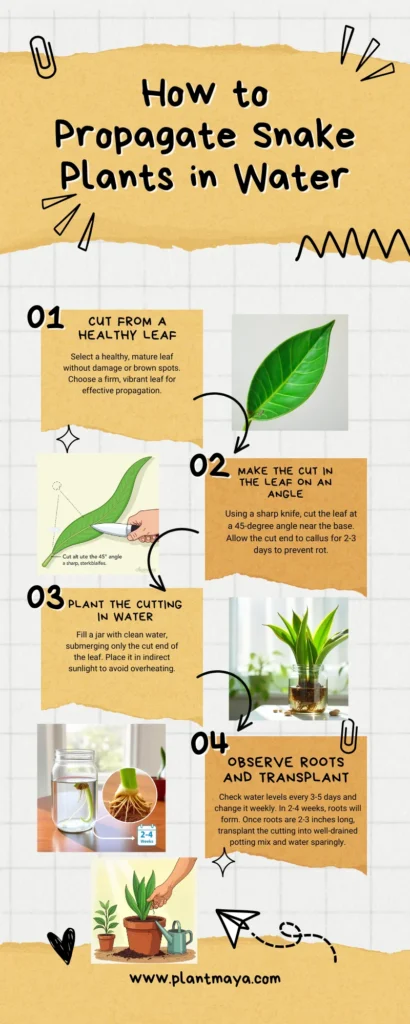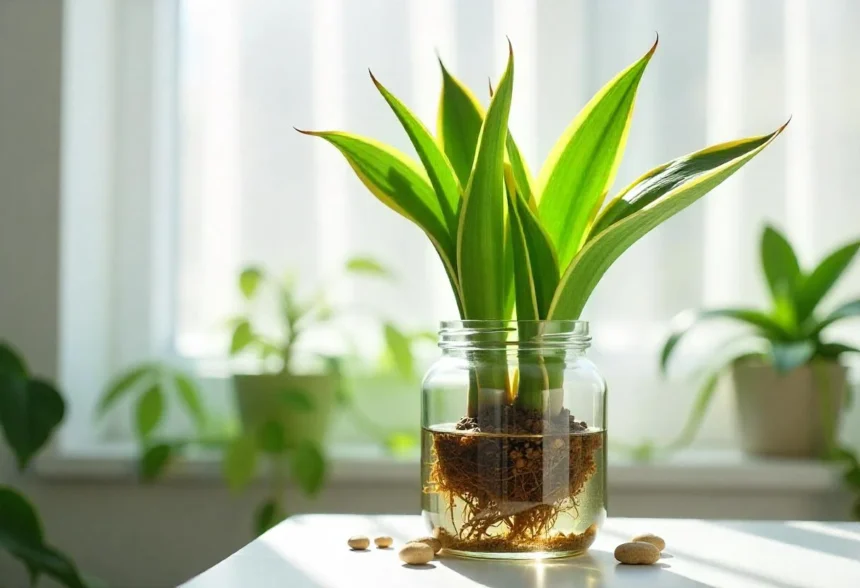I like growing snake plants in water. It’s fun! You need a leaf and cut it up. Put them in water, and wait. Sometimes, it takes a very long time. I saw roots grow, and that was cool. My friend says it’s easy, but for me, I think it is hard. The Snaky plants have big leaves and look neat. I don’t know why they call them snakey. The water gets yucky, so change it. Light is good for planty. Don’t put in the sun or get hot. I try to make more plants this way. Works good sometimes. Roots get big then out in dirt. Dirt is messy but okay. Plants grow slow, so be patient. I like watching them get big. Neat to see new baby plants. Sometimes give them to my friends; they like it, too. Snake plants are tough and don’t die easily. That’s good, because I forget water sometimes. Oops!
Why Propagate Snake Plants in Water? Tips for Propagating Snake Plant in Water
The snake plants, commonly known as Mother-in-Law’s Tongue, are among the hardiest plants to propagate. While there are several methods for propagating these popular houseplants, water propagation is among efficient ones. Here are some of its advantages:
Visibility: It can be seen through water propagation, the root development thereof.
It is cleaner compared to soil propagation and very easy to start off with.
These cuttings set in water in a decorative glass jar will add to your décor.
“Curious about growing snake plants in water? Find out how with our comprehensive guide!”
Materials You Will Need to Propagate Snake Plants in Water
Before going into the steps to follow, have the following ready:
An enthusiastically healthy snake plant cutting
A very sharp, sterilized knife or pair of scissors
A glass or clear jar-for visibility of root growth
Clean, filtered water
Step 1: Cut from a Healthy Leaf of Your Plant
You will start by choosing a healthy, grown mature leaf from your snake plant. It should be a leaf that doesn’t have too much damage or brown spots, since this could impede successful propagation. Choose a firm, brightly colored leaf. Healthy leaves mean a healthy propagation.
Step 2: Make the Cut in the Leaf on an Angle
Cut the leaf at a 45-degree angle near the base of plant using a sharp, sterilized knife or scissors. That angle allows more roots to form on a larger surface area. Let the leaf callus by placing it in a warm, dry location for 2-3 days after making the cut. Drying the cut end will prevent rot, when water is introduced.
Step 3: Plant the Cutting for Propagating Snake Plant in Water
Place the cutting in a glass or container filled with fresh water that has been passed through a filter, ensuring no more than the cut end of the leaf is submerged. Do not submerge the whole leaf to avoid its rotting. Place the container in indirect sunlight, as direct sunlight increases the temperature of the water, which might destroy the cutting.
Step 4: Observe Water and Root Development
Every 3-5 days, check the water level of your container. But if it has dropped add more water. If bacteria build up occurs, then change the water completely once a week. If you have not done so already, within 2 to 4 weeks tiny roots will start to appear and it is quite an awesome experience watching them come from nothing. The roots grow a lot longer every day.
Step 5: Transplant Your Snake Plant Once Roots Have Formed
Once your roots are about 2-3 inches long, it’s time to transfer your snake plant cutting into the soil. Gently remove the cutting from the water and place it into a well-draining potting mix. This will help the plant acclimate to the new environment. Water sparingly, and set the plant in indirect sunlight.
Why is Propagating Snake Plants in Water So Popular?
Water propagation is cleaner and easier to control than soil propagation. It works great when you’re a beginner, or if you want to have cuttings displayed around the house. The snake plant also becomes popular because it can tolerate neglect and requires the least care once established.
Benefits of Water Propagation
- Beauty: Watching those little roots rooting helps the sciencey part more fun and interesting.
- Water propagation lessens the risk of rot: You can observe root formation and see whether or not bloom rot may have formed (harder to detect when plants are in soil).
- Decor and Propagation in One: The right jar can take an ordinary propagation tool to extraordinary works of art for your windowsill or desk.
Common Mistakes When Propagating in Water and How to Avoid Them
- Submerging too much of the Leaf: Make sure to submerge only the cut end of the leaf in water, as any more can cause rot.
- Verdict: It does not like dirty or tap water as chlorine can cause this plant to burn. Make sure to use clean, filtered water to avoid any potential harm to your plant.
- Failing to Let the Cutting Callus Over: The first thing that you really want to avoid is rot at this stage. Make sure that the cutting air is free from water and dry for a day or two before submerging into water.
Propagation of Snake Plants in Water: Some Questions Answered
How Much Time Does It Take to Root Snake Plants in Water?
This might change depending on other factors such as light and temperature conditions. In general, snake plants are supposed to give roots for the propagation in water within a period of 2 to 4 weeks. However, some may take up to 6 weeks to develop roots. Patience is key!
Can I Leave My Snake Plant in Water Permanently?
While this may be okay, and in fact indefinite, for some plants, like pothos, snake plants really prefer to be transferred into soil as they continue growing and progressing. The longer it stays in water, there is a chance that the plant may have nutrient deficiencies; water cannot provide all nutrients, especially the ones that come from minerals in the ground.
What Should I Do if My Snake Plant Cutting Begins to Rot?
If you notice any kind of rot, immediately cut away the portion of the leaf that is rotten. If the cutting is too far gone, it would be better to start with fresh leaves altogether.
Best Practices for Long-Term Care after Propagating Snake Plant in Water
You will now need to start taking proper care of your new plant once you have it in water and the roots have formed. Here’s how you’ll take care of the snake plant in the long run:
Watering: Snake plants are those types of plants that like to stay dry. Allow the soil to dry out between each waterings, especially in winter where growth is at its minimum.
Light: Snake plants thrive in filtered sun and are generally happy with low light. For optimal growth, place them next to a bright-light window during any part of the day.
Soil: Following repotting, snake plants like potting mix that is well-draining. A succulent or cactus mix would be great. Have the container with holes at the bottom so the water can come out when poured into it and prevent decaying the root.
Fertilizing: Fertilize sparingly. Normally, one application of balanced houseplant fertilizer during the spring or summer growing season is sufficient. Snake plants do not need heavy feeding.
Repotting: Snake plants grow slowly and do not need frequent repotting. Repot only when the roots begin to grow out of the container or become pot-bound. Choose a larger container with good drainage.
Follow these care tips after the propagation of snake plant in water, and you will have new plants blooming and continuing in their lustrous glory.
Troubleshooting Some Common Problems When Propagating Snake Plants in Water
Although snake plants are not pretty demanding, you may still face a few problems in propagating them. Here are some of the general problems and how you could deal with them.
Not Developing Roots: If nothing has happened to your cuttings after several weeks, that may be due to the low light. Make sure your cuttings have as much indirect sunlight as possible. Also, place these cuttings in relatively warmer places and change the water frequently for inducing root growth.
Yellow Leaves: Yellow leaves can be a sign of too much direct sunlight or that the cuttings have stayed in stale water for too long. Keep your cutting under indirect light and note that you will be able to prevent bacterial growth by changing the water.
Slime on the Leaf Cutting: A slimy coating on your cutting is a sign that bacterial buildup has occurred in the water. Take out the cuttings, gently clean them under flowing, clean water, refresh the jar with filtered water, and trim any rotted or slimy areas, allowing the cuttings some air time before returning them to water.
Conclusion: Begin Your Snake Plant Propagation Today
One of the most satisfying ways to gain plants is by rooting snake plants in water. This is the easiest, cleanest, and the most visually pleasing way to clone new plants whether you are a plant newbie or an experienced plant parent. If you stick with these steps and remember a couple best practices, your snake plant will grow to be a veritable forest of snake plants.
If you are wanting to know how to propagate snake plants in water, then this is the ideal time.
To enhance your plant care skills further, explore our guides on [Snake Plant Care: The Ultimate Guide to Helping Your Sansevieria Thrive] and [Indoor Plant Care: How to Repot and Propagate Your Snake Plant].









